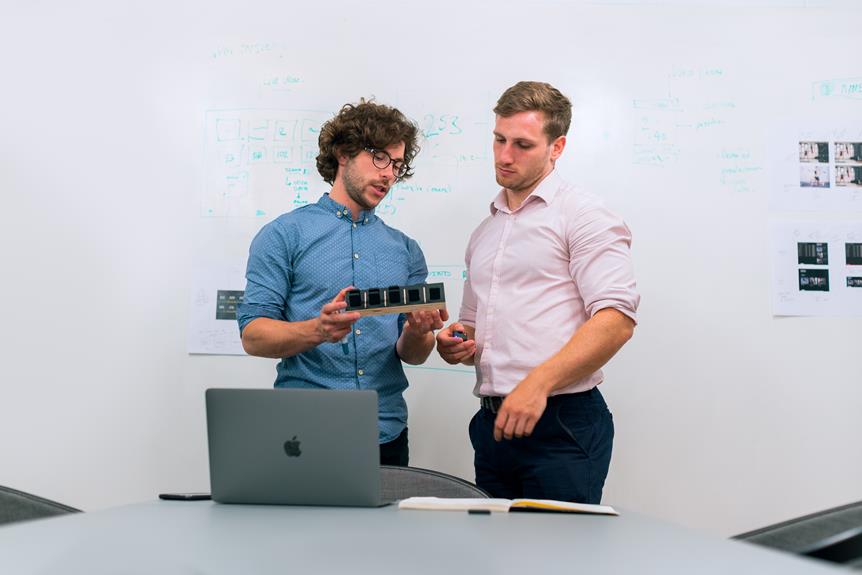Rapid Prototyping Services for Efficient Product Development
In the fast-paced world of product development, time is of the essence. Rapid prototyping services offer a solution that combines speed and efficiency to bring ideas to life.
By utilizing cutting-edge technologies and techniques, these services enable businesses to streamline their product development process. This article explores the benefits, types of technologies, and factors to consider when choosing a rapid prototyping service provider.
Additionally, case studies, tips, and future trends will be examined to provide a comprehensive understanding of how rapid prototyping can enhance product development efficiency.
Key Takeaways
- Rapid prototyping services revolutionize the way products are designed and manufactured, leading to faster and more efficient product development.
- These services allow for quick creation of physical models for testing and refinement, reducing overall development time and enabling greater design flexibility.
- Rapid prototyping technologies such as Stereolithography (SLA), Selective Laser Sintering (SLS), and Fused Deposition Modeling (FDM) offer different advantages and limitations, depending on desired material properties, design complexity, and time constraints.
- Factors to consider when choosing the right technology and service provider include precision, surface finish, material compatibility, provider expertise, prototyping technologies and materials available, turnaround time, production capacity, and communication and collaboration capabilities.
Benefits of Rapid Prototyping Services
One of the main advantages of utilizing rapid prototyping services is that they allow for faster and more efficient product development. Rapid prototyping services, such as industrial 3D printing services and custom 3D printing services, have revolutionized the way products are designed and manufactured. With rapid prototyping, designers and engineers can quickly create physical models of their concepts, allowing them to test and refine their ideas before moving on to full-scale production.
In traditional product development processes, the time and cost required to create physical prototypes can be significant. However, rapid prototyping services offer a solution to this problem by using advanced technologies to transform digital designs into tangible prototypes. This enables designers to iterate and make adjustments more quickly, reducing the overall development time.
Furthermore, rapid prototyping services allow for greater design flexibility. With the ability to quickly produce multiple iterations of a product, designers can explore different design options and make informed decisions based on physical prototypes. This iterative design process contributes to improved product quality and functionality.
Additionally, rapid prototyping services enable more efficient communication and collaboration among team members. By having a physical prototype in hand, stakeholders can better visualize and understand the design, facilitating clearer discussions and faster decision-making.
Types of Rapid Prototyping Technologies
When it comes to rapid prototyping, there are several common methods that are widely used. These include but are not limited to, stereolithography (SLA), selective laser sintering (SLS), and fused deposition modeling (FDM).
Each of these technologies has its own advantages and limitations, and the choice of which method to use depends on factors such as the desired material properties, complexity of the design, and time constraints.
It is essential to carefully evaluate these different technologies to ensure the right one is chosen for efficient and effective product development.
Common Rapid Prototyping Methods
Commonly, rapid prototyping methods are employed to expedite product development processes. These methods utilize various technologies to quickly create physical prototypes of products. Three common rapid prototyping methods include stereolithography (SLA), selective laser sintering (SLS), and fused deposition modeling (FDM).
SLA involves using ultraviolet lasers to solidify liquid photopolymer resin layer by layer. This method is known for its high accuracy and smooth surface finish.
SLS, on the other hand, uses a high-powered laser to selectively fuse powdered material, such as nylon or metal, into solid layers. It is particularly suitable for creating complex geometries and functional prototypes.
FDM, the most widely used method, works by extruding melted thermoplastic material through a nozzle, layer by layer, to build the prototype. It offers good mechanical properties and is cost-effective.
Choosing the Right Technology
To ensure optimal results, it is crucial to carefully evaluate and select the appropriate technology for rapid prototyping. The choice of technology can significantly impact the efficiency and accuracy of the prototyping process, as well as the final product. Here are three types of rapid prototyping technologies that should be considered:
- Stereolithography (SLA): This technology uses a UV laser to solidify liquid photopolymer resin layer by layer, creating a 3D object. SLA offers high precision and smooth surface finish, making it suitable for intricate designs and detailed prototypes.
- Selective Laser Sintering (SLS): In SLS, a high-powered laser selectively fuses powdered material, such as nylon or metal, together to create a solid object. SLS is known for its versatility, as it can handle a wide range of materials and produce functional prototypes with good mechanical properties.
- Fused Deposition Modeling (FDM): FDM extrudes thermoplastic material layer by layer to build the prototype. This technology is widely used due to its affordability and accessibility. However, FDM may not achieve the same level of precision and surface finish as SLA or SLS.
Choosing the Right Rapid Prototyping Service Provider
Selecting the appropriate rapid prototyping service provider is crucial for achieving efficient and successful product development. When choosing a rapid prototyping service provider, there are several factors that need to be considered.
Firstly, it is important to assess the capabilities and expertise of the service provider. Look for a provider that has experience in your industry and has a track record of delivering high-quality prototypes. Consider their range of prototyping technologies and materials to ensure they can meet your specific requirements.
Secondly, consider the provider's turnaround time and production capacity. Rapid prototyping is all about speed, so it is essential to select a provider that can deliver prototypes quickly and efficiently. Assess their production capabilities and ensure they have the capacity to handle your project's demands.
Additionally, it is crucial to evaluate the provider's communication and collaboration capabilities. Effective communication is vital for successful product development, so choose a provider that is responsive and can provide regular updates on the progress of your project. Look for a provider that values collaboration and is willing to work closely with your team to refine and iterate on the prototypes.
Lastly, consider the provider's pricing structure and overall cost. While cost should not be the sole determining factor, it is important to find a provider that offers competitive pricing without compromising on quality or service.
Factors to Consider for Efficient Product Development
One of the key factors to consider for efficient product development is the alignment between the product's features and the target market's needs and preferences. This is crucial because developing a product that meets the specific requirements of the target market ensures a higher likelihood of success.
To achieve this alignment, there are several factors that need to be taken into account:
- Conduct thorough market research: Before beginning the product development process, it is essential to gather as much information as possible about the target market. This includes understanding their demographics, behaviors, preferences, and pain points. Market research helps in identifying the gaps in the market that the product can address, and also provides insights into the features and functionalities that the target market desires.
- Continuous customer feedback: Throughout the product development process, it is important to seek feedback from potential customers. This can be done through surveys, interviews, or focus groups. By involving the target market in the development process, it becomes easier to identify any shortcomings or areas for improvement, and make necessary adjustments to ensure the final product meets their expectations.
- Iterative development approach: Adopting an iterative development approach allows for faster and more efficient product development. This involves developing the product in small increments, testing it, gathering feedback, and making improvements before moving on to the next iteration. This iterative process ensures that the product is constantly refined and optimized based on the target market's needs and preferences.
Case Studies: Successful Product Development With Rapid Prototyping
The successful product development with rapid prototyping can be demonstrated through various case studies. One such case study is the development of a new medical device. The company wanted to create a device that would improve patient care and reduce costs. They used rapid prototyping to quickly iterate and refine their design. By creating multiple prototypes, they were able to test and validate different features and functionalities before finalizing the design. This iterative approach allowed them to identify and address potential issues early in the development process, saving time and resources.
Another case study involves the development of a new consumer electronics product. The company wanted to create a sleek and ergonomic design that would stand out in the market. They used rapid prototyping to create physical models of their design concepts. By testing these prototypes with potential users, they were able to gather valuable feedback and make necessary design changes. This iterative process helped them create a final product that not only met the functional requirements but also exceeded user expectations.
In both cases, rapid prototyping played a crucial role in the successful development of the products. It allowed for efficient design iterations, reduced development time, and helped identify and address potential issues early on. These case studies demonstrate the effectiveness of rapid prototyping in product development and highlight its importance in achieving successful outcomes.
Maximizing Efficiency With Rapid Prototyping Tools and Techniques
To maximize efficiency in product development, it is crucial to employ cost-effective prototyping methods and streamline the overall process. Utilizing rapid prototyping tools and techniques can help achieve these goals by reducing development time and costs, improving communication and collaboration, and enabling quick iterations and feedback.
Cost-Effective Prototyping Methods
There are several cost-effective prototyping methods that can maximize efficiency when utilizing rapid prototyping tools and techniques. These methods allow businesses to develop and test product designs quickly and economically, reducing time-to-market and minimizing development costs.
Here are three cost-effective prototyping methods:
- 3D Printing: This additive manufacturing process allows for the creation of physical prototypes directly from CAD models. 3D printing is particularly useful for complex geometries and small-scale production runs, offering cost savings compared to traditional manufacturing methods.
- CNC Machining: Computer Numerical Control (CNC) machining utilizes computer-controlled tools to create precise prototypes from a wide range of materials. This method is ideal for producing high-quality prototypes with excellent surface finishes, making it suitable for functional testing and market validation.
- Rapid Tooling: Rapid tooling techniques, like soft tooling and 3D printed molds, enable the production of low-volume prototypes and small-scale production parts. By reducing the time and cost associated with traditional mold making, rapid tooling allows for quick iterations and cost-effective testing of product designs.
Streamlining Product Development
By utilizing rapid prototyping tools and techniques, businesses can streamline product development, increasing efficiency and reducing time-to-market. Rapid prototyping allows for the quick creation of physical prototypes or models, enabling businesses to test and validate their designs before moving into production. This helps to identify and resolve any design flaws or functional issues early in the development process, saving both time and resources.
Rapid prototyping also promotes collaboration and communication between different teams involved in the product development process, as it provides a tangible representation of the design that can be easily shared and discussed. Additionally, rapid prototyping tools and techniques offer the flexibility to iterate and make design modifications quickly, allowing businesses to respond to customer feedback and market demands more effectively.
Common Challenges in Product Development and How Rapid Prototyping Can Help
One of the most significant challenges in product development is the lack of efficient prototyping methods to test and validate designs before production. Traditional prototyping methods are time-consuming and expensive, often requiring the creation of expensive molds or tooling. This can lead to delays in the development process and increased costs.
However, rapid prototyping services offer a solution to these challenges. Here are three ways in which rapid prototyping can help overcome common challenges in product development:
- Faster Iterations: Rapid prototyping allows for quick and iterative testing of design concepts. With the ability to rapidly create physical prototypes using 3D printing or CNC machining, designers can quickly identify and address design flaws or improvements. This iterative process helps to refine the design and reduce the risk of costly errors during production.
- Cost Savings: By using rapid prototyping, companies can avoid the need for expensive molds or tooling. This significantly reduces upfront costs and allows for more flexibility in the design process. Additionally, identifying and addressing design issues early on through rapid prototyping can save money by avoiding costly rework or production delays.
- Improved Collaboration: Rapid prototyping enables cross-functional teams to collaborate more effectively. By creating physical prototypes that can be touched and evaluated, designers, engineers, and stakeholders can better understand the product and provide valuable feedback. This collaborative approach helps to ensure that the final product meets the desired specifications and requirements.
Tips for Streamlining the Rapid Prototyping Process
To streamline the rapid prototyping process, it is essential to implement efficient strategies and best practices. One important tip is to carefully plan and define the objectives of the prototype before starting the development process. This includes identifying the specific features and functionalities that need to be tested and validated. By having a clear understanding of the goals, the development team can focus their efforts and avoid unnecessary iterations or revisions.
Another tip is to leverage the power of digital technologies. Utilizing computer-aided design (CAD) software can greatly enhance the rapid prototyping process. CAD allows for easy modifications and iterations, reducing the time and cost associated with physical prototyping. Additionally, using simulation tools can help predict the performance and behavior of the product before manufacturing, reducing the need for multiple iterations.
Collaboration and communication are also crucial for streamlining the process. Establishing effective channels of communication between the development team, stakeholders, and clients can help ensure that everyone is aligned with the project goals and requirements. Regular meetings and progress updates can facilitate the early identification of issues and allow for prompt resolutions.
Future Trends in Rapid Prototyping for Product Development
What are the potential future trends in rapid prototyping for product development?
- Advanced Materials: One of the future trends in rapid prototyping is the development and utilization of advanced materials. Currently, most rapid prototyping processes use plastic materials such as ABS or PLA. However, there is a growing demand for prototyping with materials that closely resemble the final product, such as metals, ceramics, and composites. Researchers are continuously exploring new materials and improving existing ones to meet this demand. These advanced materials will enable more accurate and functional prototypes, bringing them closer to the final product.
- Multi-material and Multi-functional Prototyping: Another future trend in rapid prototyping is the ability to create prototypes with multiple materials and functions. Currently, most rapid prototyping processes can only work with a single material. However, there is a need for prototypes that can mimic the complexity and diversity of the final product. Researchers are working towards developing technologies that can combine different materials and functional components in a single prototype, allowing for more realistic and functional testing.
- Integration of Artificial Intelligence: As rapid prototyping technologies continue to advance, the integration of artificial intelligence (AI) is expected to play a significant role in the future. AI algorithms can analyze and interpret data from the prototyping process, enabling faster and more efficient optimization of designs. Additionally, AI can assist in automating certain aspects of the prototyping process, such as design generation or material selection. This integration of AI will not only speed up the product development cycle but also improve the quality and performance of the prototypes.
Frequently Asked Questions
How Much Does It Cost to Use Rapid Prototyping Services?
The cost of utilizing rapid prototyping services varies depending on factors such as the complexity of the product, materials used, and the desired level of detail. It is recommended to obtain quotes from multiple service providers to compare prices.
Are There Any Limitations to the Size or Complexity of Products That Can Be Developed Using Rapid Prototyping?
There are limitations to the size and complexity of products that can be developed using rapid prototyping. Factors such as machine capabilities, material properties, and design intricacies can impact the feasibility of prototyping certain products.
Can Rapid Prototyping Services Be Used for the Production of Final Products, or Are They Only for Prototyping Purposes?
Rapid prototyping services can be used for the production of final products as well as for prototyping purposes. They offer efficient and cost-effective solutions for product development, allowing companies to quickly iterate and test their designs before moving to full-scale production.
How Long Does It Typically Take to Receive a Prototype Using Rapid Prototyping Services?
The typical timeframe for receiving a prototype using rapid prototyping services varies depending on factors such as complexity, size, and material. However, it can range from a few hours to several days, ensuring efficient product development.
What Materials Are Commonly Used in Rapid Prototyping, and How Do They Compare to Traditional Manufacturing Materials in Terms of Durability and Performance?
Common materials used in rapid prototyping include plastics, metals, and ceramics. While they may not match the durability and performance of traditional manufacturing materials, rapid prototyping offers the advantage of faster and more efficient product development.
Conclusion
In conclusion, rapid prototyping services offer numerous benefits for efficient product development. By utilizing different technologies and considering factors such as cost, speed, and quality, businesses can choose the right service provider for their needs.
Successful case studies demonstrate the effectiveness of rapid prototyping in bringing products to market faster. Maximizing efficiency through tools and techniques, addressing common challenges, and streamlining the process are key for successful implementation.
As the industry evolves, future trends in rapid prototyping will continue to shape the landscape of product development.









